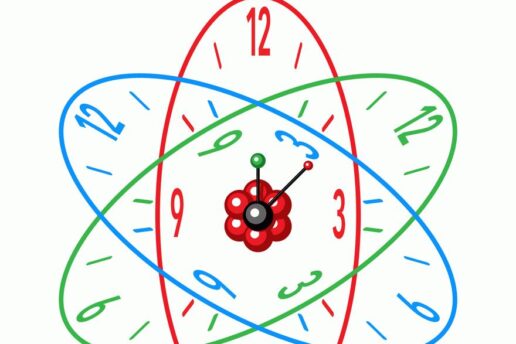
The Challenge of Measuring Time
Today’s atomic clocks are more accurate than ever, but the nature of time itself remains an enigma.
Accurate measurement of time is one of the glories of physics, and one of the most exciting frontiers of current research.
For most of history, people measured time using the sun and moon. Earth’s rotation gives us the day, its revolution around the sun gives us the year, and its dance with the moon gives us the month. Sundials used the shadow cast by the sun to track the hours, but they had drawbacks; for one thing, they didn’t work on cloudy days.
To measure briefer periods of time, hourglasses and water clocks served for many centuries, even though changes in temperature, humidity and vibration could throw them off. Mechanical clocks using falling weights and elaborate systems of gears were a high point of medieval technology. By the early 20th century, clocks with pendulums and springs had evolved into remarkable, beautifully contrived instruments. But even these clocks were subject to friction, which affects their movements and wears away their parts.
Increased understanding of electromagnetism and of matter in general made even better clocks possible. Flows of electrons replaced flows of sand or water; electromagnetic fields replaced gears; tiny quartz crystals replaced springs. Today’s cutting-edge clocks are based on measuring the vibrations of atoms and molecules. The most precise atomic clocks are so accurate that, over a period of time equivalent to the whole history of the universe to date, they would be off by less than one second.
Today’s quantum horologists are looking to improve things further. For instance, it might be possible to monitor atomic nuclei, which vibrate faster than whole atoms. More accurate clocks would help physicists determine whether time is truly continuous or fundamentally granular, made from units yet to be detected. More tangible applications of better timekeeping abound as well, from developing better GPS systems to detecting passing gravitational waves.
It is an amazing fact, too easily taken for granted, that all these radically different sorts of clocks agree with one another. In different moods we might feel time’s flow to be a surge or an ooze, but its rigorous uniformity is an objective feature of physical reality.
Even as we get better at measuring time, however, its nature remains hard to grasp. One of the best philosophical discussions of time can be found in chapter 11 of St. Augustine’s “Confessions,” written in 397-98. Augustine was a Christian bishop, and one of his parishioners asked him a vexing question: “What was God doing before creation?” Augustine considered, but rejected, the answer “He was preparing hell for those who pry into mysteries.” Instead, he took the question seriously—and got to its root.
Whenever we use terms like before and after, Augustine reasoned, we are speaking of time, whose essence seems mysterious: “What is time? If no one asks me, I know, but if I try to explain it, I cannot.” But he discovered a principle that anticipates a major theme of relativity and quantum theory: To understand what something is, you must think about how it is measured. As Augustine puts it, “What we measure not, is not.”
Following this logic, Augustine’s answer to “What is time?” is simple: “Time is what clocks measure.” With that understanding, the parishioner’s question dissolves. Before creation there were no clocks, and without clocks there could be no time. Today, in physical cosmology, the parishioner’s question is still with us, in the form “What happened before the Big Bang?” I suspect that Augustine’s answer might still be the best one we have: To ask about “before,” in that timeless context, is literally senseless.
Originally appeared on May 22, 2019 on The Wall Street Journal website as ‘The Challenge of Measuring Time‘
Frank Wilczek is the Herman Feshbach Professor of Physics at MIT, winner of the 2004 Nobel Prize in Physics, and author of the books Fundamentals: Ten Keys to Reality (2021), A Beautiful Question: Finding Nature’s Deep Design (2015), and The Lightness of Being: Mass, Ether, and the Unification of Forces (2009).